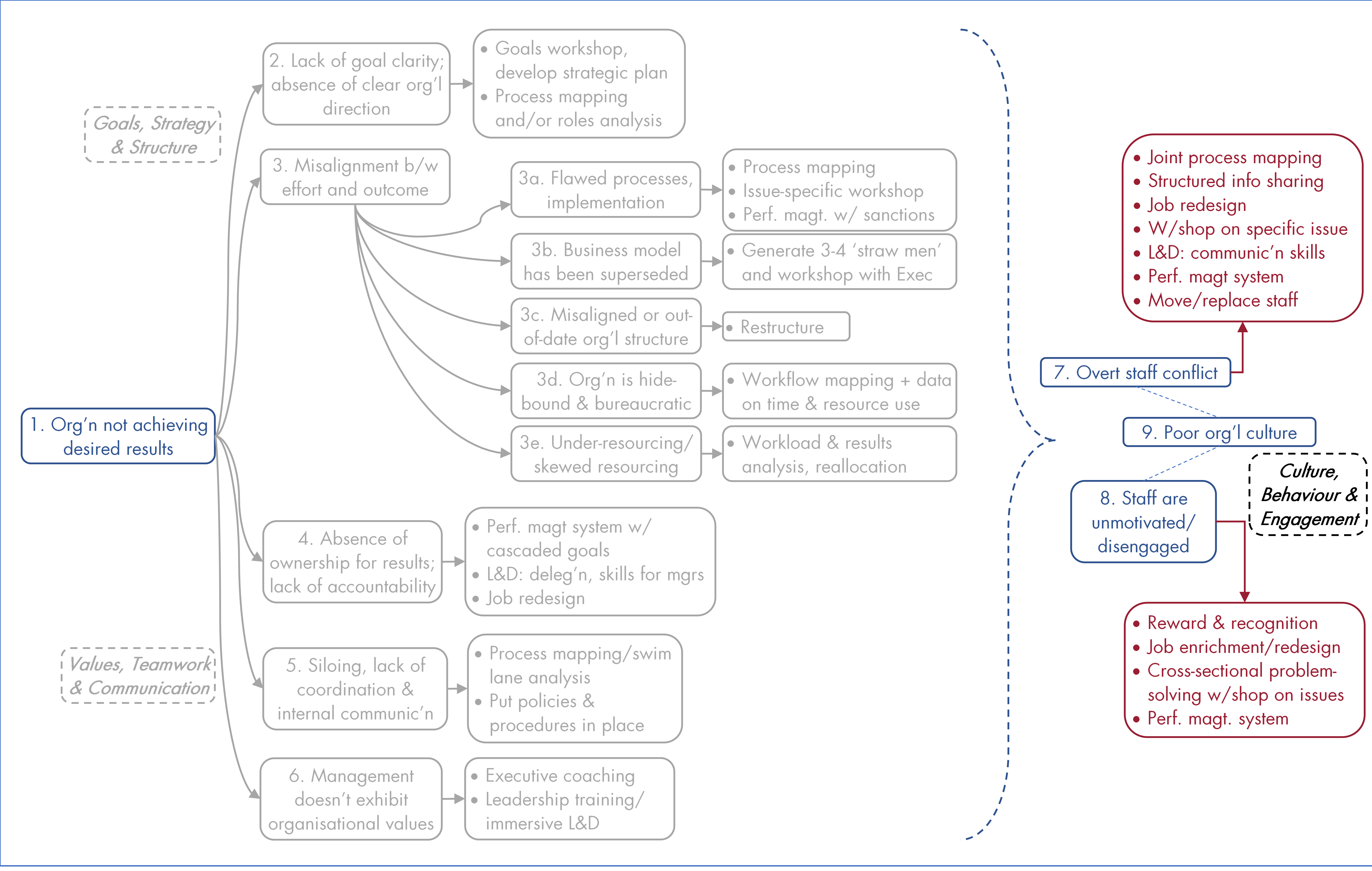Your 2020 Management Ready Reckoner - Part 3: Culture, Behaviour & Engagement
Welcome to the final instalment in this three-part series providing a ‘ready reckoner’ for key management issues. The first part, dealing with Goals, Strategy & Structure can be found here, and the second, dealing with Values, Teamwork & Communication here.
We’ve been looking at an organisation that is not achieving the results it would like to, owing to a range of causes including absence of goal clarity, lack of accountability, siloing, and management not exhibiting organisational values.
In this newsletter we look at organisational shortcomings due to:
- Staff conflict
- Staff being unmotivated or disengaged, and
- Poor organisational culture.
These Values, Teamwork and Communication Issues are represented in the diagram below by bubbles 7, 8 and 9.

Assuming that the problems have been correctly diagnosed, how would we go about addressing these shortcomings? As in previous issues, I’ve shown my recommended solutions for dealing with the problems in the diagram above: problems are in blue, solutions in red.
Managing Staff Conflict
As Peter Drucker observed, it’s a law of physics that bodies coming into contact generate friction.
Aside from the occasional flare-up because someone got out of the wrong side of bed, what causes conflict?
To some extent we’ve already addressed that question … any of the causes we’ve already looked at might cause conflict:
- Lack of clarity about the direction of the organisation can cause confusion, duplication of effort or inertia … all of which are potential triggers for conflict
- Any of the contributing factors leading to misalignment between effort and outcome (for example flawed implementation, an out-of-date business model, a hide-bound or overly bureaucratic organisation, or under-resourcing, can lead to frustration and disputes
- People not taking ownership for results is an obvious ground for discontent, leading as it does to finger pointing or duck-shoving
- Siloing and lack of coordination leads to crossed wires or work not being properly completed – thereby facilitating skirmishes between people in different departments or divisions
- Management not walking the talk gives everyone a maladaptive get-out-of-jail-free card which is a licence for bad behaviour … and a highly effective generator of conflict.
Conflict is an outgrowth of these problems: the means to address each of the problems is also the means to address the conflict flowing from them.
Here is my list of the principal means to address these types of problems.
Joint process mapping is an effective way to combat lack of goal clarity, flawed implementation, bureaucracy and siloing. Structured information sharing (either by setting a formal process for information flow, or arranging regular meetings) facilitates a flow of communication that mitigates the conflict arising from crossed (or missing) wires. Job redesign can help where positions or structure are not fit-for-purpose, or people are able to ‘hide’ from the need to perform. Issue-specific workshops are useful means to solve joint problems and the discord that the latter can bring. Training/L&D on communication and soft skills can help smooth fractious workplace relations by giving people strategies to manage situations that would otherwise risk rapidly turning south. A performance management system is an important means of cascading high-level goals to teams and individuals, ensconcing accountability, and helping assure implementation … all of which are potent measures for heading off workplace wrangling. And finally, sometimes it’s just necessary to move or replace staff who create or amplify conflict.
Motivating Staff
Disengaged staff are another manifestation of the problems we’ve already examined. The same sources of conflict are likely to lead staff to be demotivated, and demotivation could flow from the workplace conflict discussed above as well.
The particular measures to focus on to address staff engagement issues include implementing a Reward & Recognition scheme to provide a means of publicly celebrating praiseworthy staff and codifying the kinds of behaviours and attitudes the organisation wants to promote. Job enrichment and redesign enable the enhancement of challenge in a particular position, which boosts motivation by giving the person holding that position a greater sense of accomplishment. A cross-sectional problem-solving workshop creates greater motivation by means of both addressing the problem which is the focus of the workshop, at the same time as creating bonds and a shared sense of purpose between staff who are collaborating on a joint enterprise. Finally, a performance management system provides a vehicle for defining, acknowledging and documenting accomplishment, as well as surfacing areas of dissatisfaction.
Repairing Poor Organisational Culture
Culture problems are the ‘receptacle’ for all the preceding issues we’ve examined in this series. A problem culture is not something separate from problems of goal clarity, misalignment of effort and outcome, absence of ownership for results, or any of the other problems we’ve discussed: it is their manifestation. It both reflects them and underpins them, in an invisible and perpetual feedback loop which defines the key facets of an organisation at a point in time. Culture is the spirit of an organisation as both manifestation of all the important aspects of that organisation (values, structure, processes and performance etc.) and as something which feeds into those.
If you don’t believe me, just look at the headline of the story in the Australian Financial Review of 24 September 2020: ‘Westpac's culture lesson: don't block bad news’. The article is part of a suite of reports on the fine payable by Westpac for its anti-money laundering breaches: a fine which – at $1.3 billion – is the largest in Australian corporate history. That’s quite the costly culture problem.
* * *
If you’d like to read more of this applied management material I am providing short (~200 word) posts on LinkedIn mid-week: click here to see my thoughts on how corporates need to manage the expectations of their powerful new stakeholders (industry super funds) and here for more on the very tangible ($1.3 billion worth of tangibility!) implications for organisational culture of the Westpac anti-money laundering failures. And please connect with me at https://au.linkedin.com/in/michaelcarman if you haven’t already.
I hope this ready reckoner of culture, behaviour and engagement solutions is useful, and that you are all staying safe and well.
Warm regards,
Michael

© Michael Carman 2020
